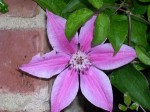 The huge flowers of clematis vines are real eye catchers when they bloom and give a romantic look to most settings. But over the years those flowers will slowly diminish in number unless you prune the plants at the proper time and that time varies with variety or cultivar. This fact is what makes pruning tricky but be comforted by the fact that you won’t kill the plant by bad pruning practices; the very worst you will do is sacrifice the blooms for that season or year.
The huge flowers of clematis vines are real eye catchers when they bloom and give a romantic look to most settings. But over the years those flowers will slowly diminish in number unless you prune the plants at the proper time and that time varies with variety or cultivar. This fact is what makes pruning tricky but be comforted by the fact that you won’t kill the plant by bad pruning practices; the very worst you will do is sacrifice the blooms for that season or year.
Here is the easy part: Every young clematis under 3 years old should be pruned back the first two years in order to encourage more shoots, better roots system and fuller vines. In the first spring a two year old plant should be pruned back to 12” and a 3 year old plant to 18”. In either case, try to leave two sets of buds on each stem between where you make your cut and soil level.
Here’s the trickier part: Some clematis are easy but others are not and unfortunately the big flowered ones that are available everywhere are the really tricky ones. If you love clematis as I do, following some pruning guidelines are worth the trouble. The key to making this as simple as possible is to determine the “pruning group” to which it belongs. The easiest way to determine this is by looking on the tag that comes with the plant when you buy it but since this tag can be elusive you can go out into the garden and observe the bloom time, a time consuming practice but ultimately productive. Try to place each clematis into one of the following groups, but remember this guideline is approximate and with exceptions:
1. Blooms in spring only (Group 1)
2. Blooms in spring AND fall or spring TO fall (Group 2)
3. Blooms in summer only (Group 3)
Group 1: Bloom in spring on old growth so prune immediately after blooming. Cut back to 2 leaf buds or to confine growth.
Examples: All of these have small flowers.
Clematis montana (‘Elizabeth’, ‘Grandiflora’, ‘Mayleen’, ‘Rubens’)
Clematis alpina (‘Blue Dancer’, ‘Helsingborg’, Pink Flamingo’)
Clematis armandii (‘Snowdrift’)
Clematis macropetala (‘Markhams Pink’)
Group 2: Prune lightly in early spring (late February or March) above swelling leaf buds being sure to remove all dead material above buds. Vary the length of the stems to produce a well-balanced plant. Deadhead to promote more blooms.
Examples: There are many and these are just a sampling; they all have large flowers.
‘Belle of Woking’
‘Carnaby’
‘Dr. Ruppel’
‘Duchess of Edinburgh’
‘General Skikorski
‘Henryi’
‘Nelly Moser’
‘Niobe’
‘Ramona’
Group 3: Blooms on new growth so prune to remove all dead material above buds in February or March as new leaf buds begin to show.
Examples:
‘Comtesse de Bouchaud’
‘Durandii’
‘Earnest Markham’
‘Hagley Hybrid’
‘Jackmanii’
‘Jackmanii Superba’
‘Perle D’Azur’
‘Victor Hugo’
C. viticella (‘Margo Koster’, ‘Polish Spirit’, ‘Violacae’)
If you look over these procedures it might occur to you that only the odd clematis in Group 1 need special attention with pruning after they flower; all the others do well with pruning sometime in early spring when leaf buds begin to form. And always remember; pruning at the wrong time will NOT kill your precious clematis!
I’m fairly ok with the pruning but I don’t get much practice as so many of my large flowered Clematis die on me. Perhaps it is my light soil. I would like more of them as they are so impressive.
Could it be that your clematis wasn’t planted deep enough? In some cases Clematis die as a result of planting them too shallowly. Treat like herbaceous and plant a little deeper. I don’t think pruning could kill Clematis?